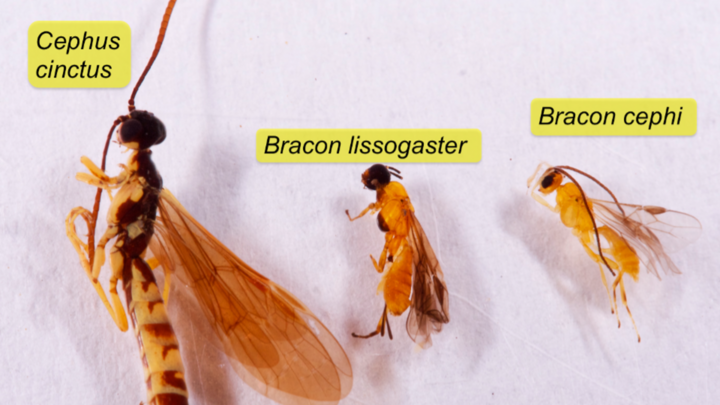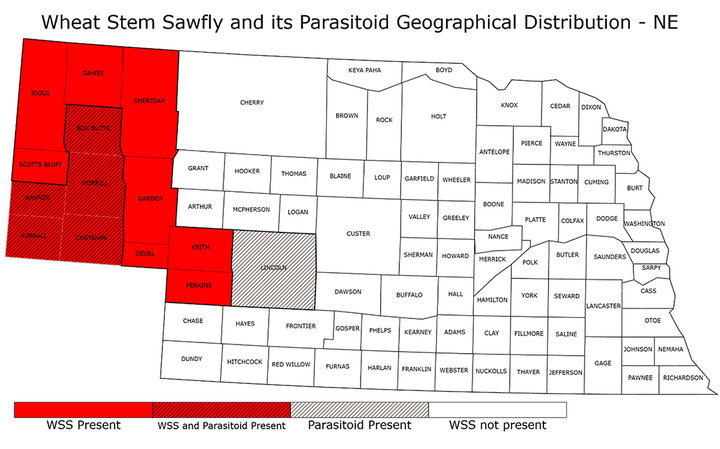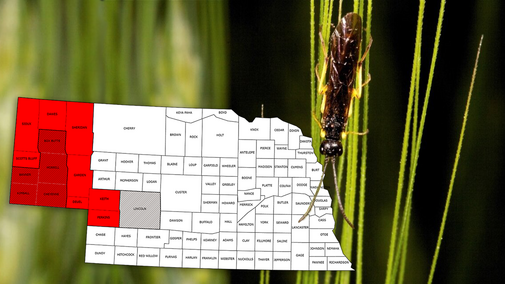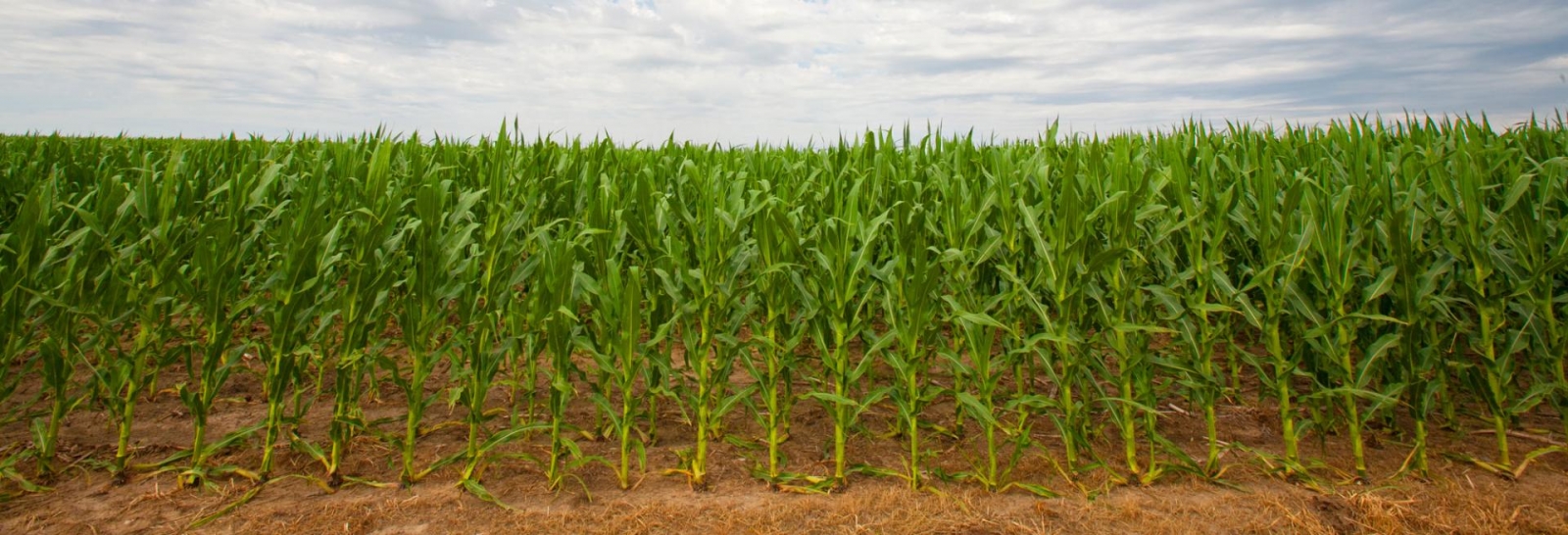Key Takeaways
Wheat stem sawfly remains a major threat: Reports in 2025 range from mild infestations to severe lodging across western Nebraska.
Parasitoids are helping: Bracon wasps are attacking WSS larvae, especially in fields with retained stubble, helping reduce damage over time.
Flight timing is now easier to predict: With Nebraska Extension GDD data incorporated into CSU’s model, the new USPest.org tool gives growers a simple way to track sawfly flight.
Scouting is essential: Begin scouting when cumulative GDD reaches the early flight threshold; look for parasitoids two to three weeks later.
Wheat stem sawfly (WSS) has once again challenged wheat growers across western Nebraska in 2025, with reports ranging from mild infestations to severe lodging.
The presence of beneficial parasitoids — natural enemies of WSS — offers some hope, but this pest remains one of the most destructive threats to dryland wheat in the northern Great Plains. Understanding its biology and emergence patterns is essential for anticipating future impacts on fields.
Lifecycle Overview
Adult wheat stem sawflies emerge in late spring, coinciding with the winter wheat stem elongation stage, and females lay eggs inside the stems. After hatching, larvae feed as they tunnel downward, weakening the stem and increasing the risk of lodging and yield loss. As the wheat reaches maturity, WSS larvae cut the stem base, creating an overwintering chamber. When adults emerge from the wheat crown the following spring, they begin their flight period. Detecting adult WSS during this time is key for planning harvest timing, fallow stubble management, and making decisions for the next growing season.
Parasitoids and WSS Control
During recent years, extension specialists and educators, and farmers have reported the presence of Bracon parasitoids — native wasps that kill WSS larvae feeding inside the wheat stems. These beneficial insects can substantially reduce WSS injury by interrupting larval feeding, which helps protect yield in the current season.
Their impact is most noticeable in fields adjacent to last year’s wheat where stubble is retained, as parasitoids pupate and emerge from the residue before moving into new wheat stands to search for WSS larvae. While they do not immediately reduce overall WSS populations, their activity lowers damage in the short term, and their numbers can build over several years to provide more consistent population suppression.

Geographic Distribution in 2025
This season’s monitoring has detected WSS activity primarily in the Nebraska Panhandle and south-central counties, with emergence occurring in early to mid-May for most of the sampled locations. In Banner and Box Butte counties, growers reported heavier stem cutting and lodging in fields where harvest was slightly delayed due to weather conditions.

How Growers Can Use the GDD Tracker
Because it is difficult to pinpoint when WSS adults will emerge, growers need a reliable tool to anticipate emergence activity. Using a model based on growing degree days (GDD) provides that prediction, helping identify when conditions are favorable for WSS emergence and guiding scouting efforts and decisions.
To better anticipate adult WSS activity, we used a generalized additive model (GAM) based on sweep net captures from 2022–2025 at the High Plains Agricultural Laboratory.
For the Panhandle region, this model predicts that WSS flight typically starts around 171 GDD, peaks at 281 GDD, and ends by 429 GDD. These estimates matched field observations taken from the past four years — for example, 50% of sawflies had emerged by 271 GDD, and 95% by 355 GDD.
This model was adapted from a study published by CSU earlier this year (Vieira et al., 2025).
How to estimate GDD for your field:
- Open the new USPest.org GDD tool.
- On the Station tab, select the weather station closest to your field.
- On the Model tab, enter these settings:
- Model category: Insects
- Model: Degree-day calculator (general purpose)
- Calculation method: Single sine
- Lower threshold: 10°C
- Upper threshold: 30°C
- To switch between °F and °C, use the temperature scale dropdown under Options
- Dates: Start date Jan. 1 and end date Dec. 31 for the year of interest.
- Click the Output tab to view results. Daily cumulative GDD appears in the sixth column, under DDs cumu. When cumulative GDD passes 170, begin scouting your wheat for adult WSS.
As GDD approaches the expected WSS emergence window, begin scouting fields using an insect sweep net to check for adults. About two to three weeks after WSS emergence, you can also start looking for parasitoids.
While we currently do not have established threshold numbers that directly correlate WSS counts to yield losses, simply knowing when WSS adults are present is an important first step. Detecting parasitoids in the field is also a positive sign, indicating natural biological control activity that may improve harvest conditions.
Final Recommendations
Understanding when wheat stem sawfly is active is critical for timely harvest planning and management. The GDD-based emergence model described here provides a practical, accessible tool to guide scouting and decision-making. As monitoring continues across Nebraska, the model will be updated to remain an important resource for understanding this pest, supporting biological control efforts, and helping growers make informed decisions.
For additional information and support, local extension educators are an excellent first-line resource. They can help growers use the GDD-based emergence model, identify WSS or Bracon specimens, and develop strategies to address WSS concerns in your wheat production systems.
References
- Vieira, H. V., Bradford, B. Z., Osterholzer, A., Peirce, E. S., Cockrell, D., Peairs, F., Frost, K., Groves, R., & Nachappa, P. (2025). A new growing degree-day phenology model for wheat stem sawfly (Hymenoptera: Cephidae) in Colorado wheat fields. PLOS ONE, 20(4), Article 4. https://doi.org/10.1371/journal.pone.0320497

